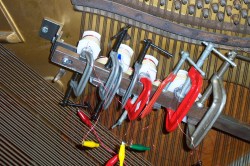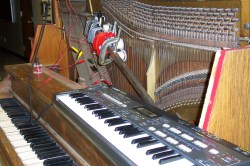
[Richard] recently rediscovered some files from a hack he did back in 2004. He was experimenting with exciting piano strings via electromagnetic fields. The idea shares some elements with the self tuning piano we saw back in 2012. Piano strings, much like guitar strings, are made of steel alloys. This means they create electricity when vibrated in a magnetic field. This is the basic principle upon which electric guitar pickups are built. The idea also works in reverse. The strings will vibrate in response to a modulated electromagnetic field. Anyone who has seen an E-bow knows how this can be applied to the guitar. What about the piano?
[Richard] started with the Casio CZ-101, a classic synth in its own right. The Casio’s output was run through a Peavy 100 watt amplifier. The amplified output was then used to drive custom coils mounted on a piano. The coils had to be custom wound to ensure they would be compatible with the 4 – 8 ohm impedance expected by the amplifier. [Richard] ended up winding the coils to 28 ohms. Six of these coils in parallel put him just over the 4 ohm mark. The coils effectively turned the piano into a giant speaker for the synth. In [Richard’s] write-up (word doc link) he mentions that the strings basically act as a giant comb filter, each resonating strongly in response to frequencies in its harmonic series.
The results are rather interesting. The slow attack of the magnetic fields coupled with the synth’s patch results in a surprising variety of sound. The three examples on [Richard’s] blog vary from sounding like a power chord on a guitar to something we’d expect to find in an early horror movie. We would love to see this idea expanded upon. More efficient coils, and more coils in general would add to the effect. The coils on various string groups could also be switched in and out of the system using MIDI control, allowing for even more flexibility.

















Never mind the piano, isn’t that a Tektronix 575 curve tracer on the bench in the background of the photo?
http://www.eecs.umich.edu/nime2012/Proceedings/papers/117_Final_Manuscript.pdf
Having just acquired a CZ-101 synth last year, I suddenly feel as if I am in much finer company now.
Picked mine up back in 2005 at a garage sale. Such a fun toy to play with!
The CZ series is really underrated – I still have my VZ-1 – all the way back from 1990, and love the sounds I get out of it.
somehow all those free pianos on C’list just became interesting again.
( only one flight of stairs to climb & no help with loading )
Makes me sick now to think of scrapping a pair old Burroughs workstations a few years back.
The printers had those belted character sets and rows of solenoids to strike at the correct location.
The driver boards were loaded with TO-220 cased Darlingtons, w/no heatsinks!
( still got the boards in a box somewhere, just seemed too nice to toss )
Oh that sounds so cool, I can imagine scraping the entire piano and just using the “harp” to produce sounds, love the sound.
Look up Choralcelo. This is another of one of those turn of the last century preelectronic wonders.
Andrew McPherson is conducing extended work on the magnetic resonator piano.
http://www.eecs.qmul.ac.uk/~andrewm/mrp.html
Your project remind me of Eric Persing and company’s efforts at Spectrasonics, who have a unique burning piano sample in their software-synth product, Omnisphere.
How about one of you guys work on a self-tuning piano. The project has been done as a one-off, but we pianists would love an acoustic piano that stays in tune in all climates.